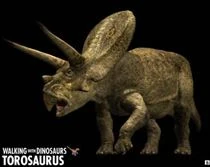Template:Dinoseries

Torosaurus
The ceratopsians, also known as the horned dinosaurs, were a group of plant-eating ornitischia or bird-hipped dinosaurs (as opposed to also plant-eating but lizard-hipped sauropodomorpha dinosaurs). They existed mainly during the late Cretaceous time period, in the Americas and also in Asia.
The ceratopsians are largely subdivided into two groups: the long-frilled and the short-frilled dinosaurs. Largely identical to each other - short but powerful legs, robust bodies, tortoise beak-like jaws and a varied number of horns - they had either a shorter, more plain frill with smaller openings that didn't extend beyond the dinosaur's neck and shoulders (the short-frilled dinosaurs) or a longer frill with larger internal openings that extended further beyond the shoulders, occassionally possessing spikes of various length on its end.
Besides the ceratopsians, there were also their smaller, more ancient cousins, the proceratopids. They differed from the ceratopsians by being much smaller in size and usually lacking any horns or frill ornaments. The colony of Protoceratops dinosaurs, featured in the second episode of Chased by Dinosaurs were typical members of the protoceratopid family.
The last episode of Walking with Dinosaurs featured Torosaurs, typical members of the long-frilled ceratopsian family. They were featured fighting for females of their herd, like modern antelope do, and they were killed when the meteorite struck at the end of the episode.
This episode also featured a dead Triceratops, a typical short-frilled ceratopsian, and one of the best known dinosaurs. It played a far greater role in Prehistoric Park, when Nigel Marvin rescued a young (juvenile) male named Theo from the K/T extinction, and it became one of the trademark creatures of Nigel's park. Featured 'in the wild' in the first episode, Triceratopses grazed in herds (as the Torosaurs did in Walking with Dinosaurs) and used group defence when confronted by the Tyrannosaurs. Just like the Torosaurs and other dinosaurs, Triceratops died out by 65 MYA.
Both March of the Dinosaurs and the upcoming WWD:3-D film will feature Pachyrhinosaurus, a more distant cousin of Triceratops and Torosaurus. Unlike them, Pachyrhinosaurus didn't have any horns on its nose, but rather a thick boss of bone or keratin instead. It also had a forwards-jutting horn-like structure above its head. Pachyrhinosaurus' behavior was probably similar to the other ceratopsians showed by Impossible Pictures (though perhaps more migratory) and like the other dinosaurs Pachyrhinosaurus died out by 65 MYA.
